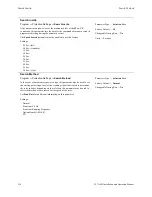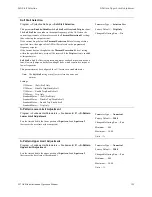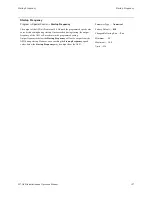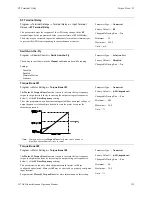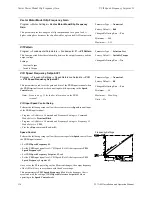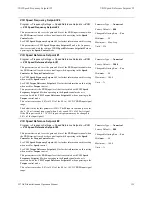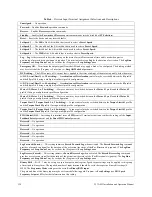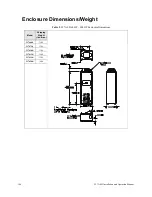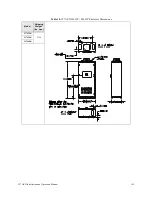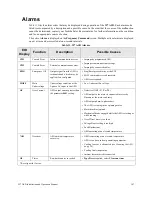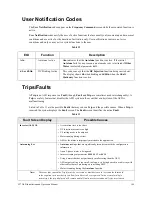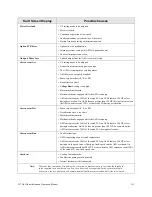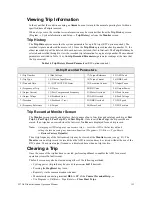
138
W7 ASD Installation and Operation Manual
Table 6. Discrete Input Terminal Assignment Selections and Descriptions.
Unassigned — No operation.
Forward — Enables Forward operation commands.
Reverse — Enables Reverse operation commands.
Standby — Enables the Forward and Reverse operation commands (maybe disabled at ST Selection).
Reset — Resets the device and any incurred faults.
Set Speed 1 — The LSB of the 4-bit nibble that is used to select a Preset Speed.
Set Speed 2 — The second bit of the 4-bit nibble that is used to select a Preset Speed.
Set Speed 3 — The third bit of the 4-bit nibble that is used to select a Preset Speed.
Set Speed 4 — The MSB of the 4-bit nibble that is used to select a Preset Speed.
Jog — Jog is the term used to describe turning on the motor for small increments of time and is used when precise
positioning of motor-driven equipment is required. This terminal activates a Jog for the duration of activation. The Jog Run
Frequency and Stop Control may be set from the (Program
⇒)
Freq Settings menu.
Emergency Off — Terminates the output signal from the ASD and may apply a brake if so configured. The braking method
may be selected at the (Program
⇒ Protection ⇒)
Emg Off Mode Sel parameter.
DC Braking — The ASD outputs a DC current that is applied to the stator windings of the motor to quickly brake the motor.
A/D 1/2 (Accel/Decel 1-to-2 Switching) — Acceleration and Deceleration control may be switched between the #1 profile
and the #2 profile if using a multiple-accel/decel profile configuration.
A/D 3/4 (Accel/Decel 3-to-4 Switching) — Acceleration and Deceleration control may be switched between the #3 profile
and the #4 profile if using a multiple-accel/decel profile configuration.
Motor 1/2 (Motor 1-to-2 Switching) — Motor control may be switched between the Motor #1 profile and the Motor #2
profile if using a multiple-motor profile configuration.
Motor 3/4 (Motor 3-to-4 Switching) — Motor control may be switched between the Motor #3 profile and the Motor #4
profile if using a multiple-motor profile configuration.
Torque Lim 1/2 (Torque Limit 1-to-2 Switching) — Torque control may be switched between the Torque Limit #1 profile
and the Torque Limit #2 profile if using a multiple-profile configuration.
Torque Lim 3/4 (Torque Limit 3-to-4 Switching) — Torque control may be switched between the Torque Limit #3 profile
and the Torque Limit #4 profile if using a multiple-profile configuration.
PID (Control) Off — Activating this terminal turns off PID control. Terminal activation overrides the settings of the Input
Feedback Select parameter and the Panel PID Control parameter.
Reserved — No operation.
Reserved — No operation.
Reserved — No operation.
Reserved — No operation.
Reserved — No operation.
Reserved — No operation.
Jog Forward (Forced) — This setting initiates a Forced Forward Jog when activated. The Forced Forward Jog command
provides a forward-run signal for the duration of the activation (the status of the F or R terminals is ignored). The Jog Run
Frequency and Stop Control may be set from the (Program
⇒)
Freq Settings menu.
Jog Reverse (Forced) — This setting initiates a Forced Reverse Jog when activated. The Forced Reverse Jog command
provides a reverse-run signal for the duration of the activation (the status of the F or R terminals is ignored). The Jog Run
Frequency and Stop Control may be set from the (Program
⇒)
Freq Settings menu.
Binary Bit 0 — Bit 0 – 7 may be set up as a speed/torque control register. Speed/torque settings may be applied to this group
of terminals in binary form. The required number of input terminals should be set to the respective binary bit settings (0 –
MSB). The Frequency Mode setting must be set to Use Binary/BCD input.
The gain and bias of the binary input may be set from the following path: Program
⇒
Freq Settings (see
BIN Speed
Frequency Setpoint #1
for further information on this setting.

